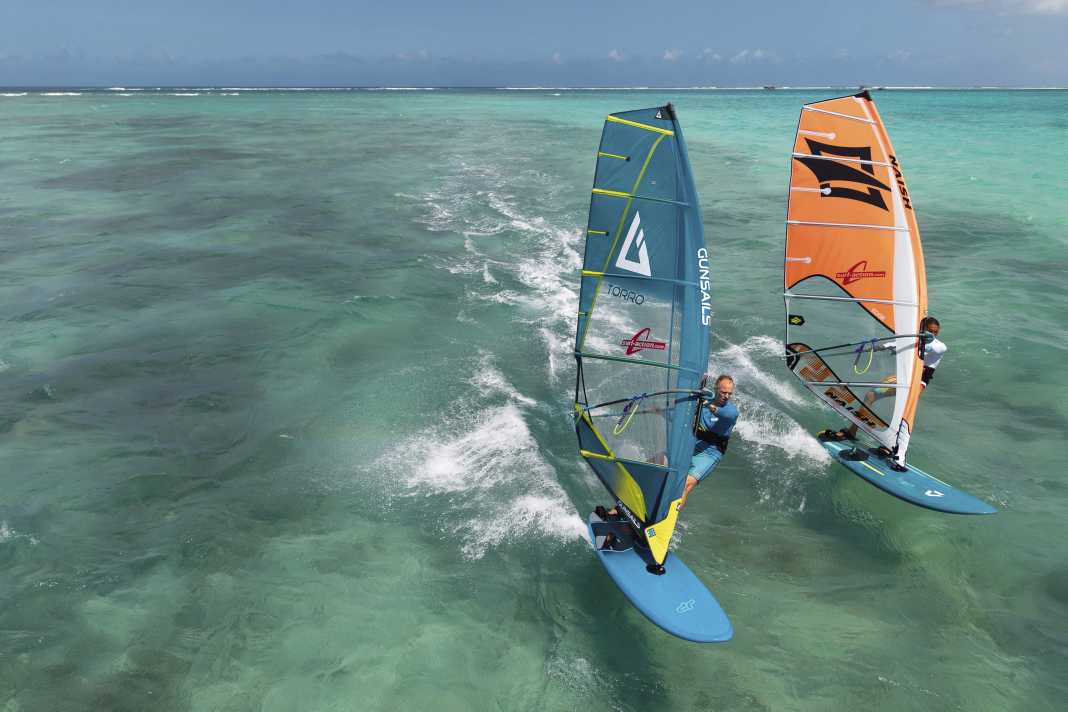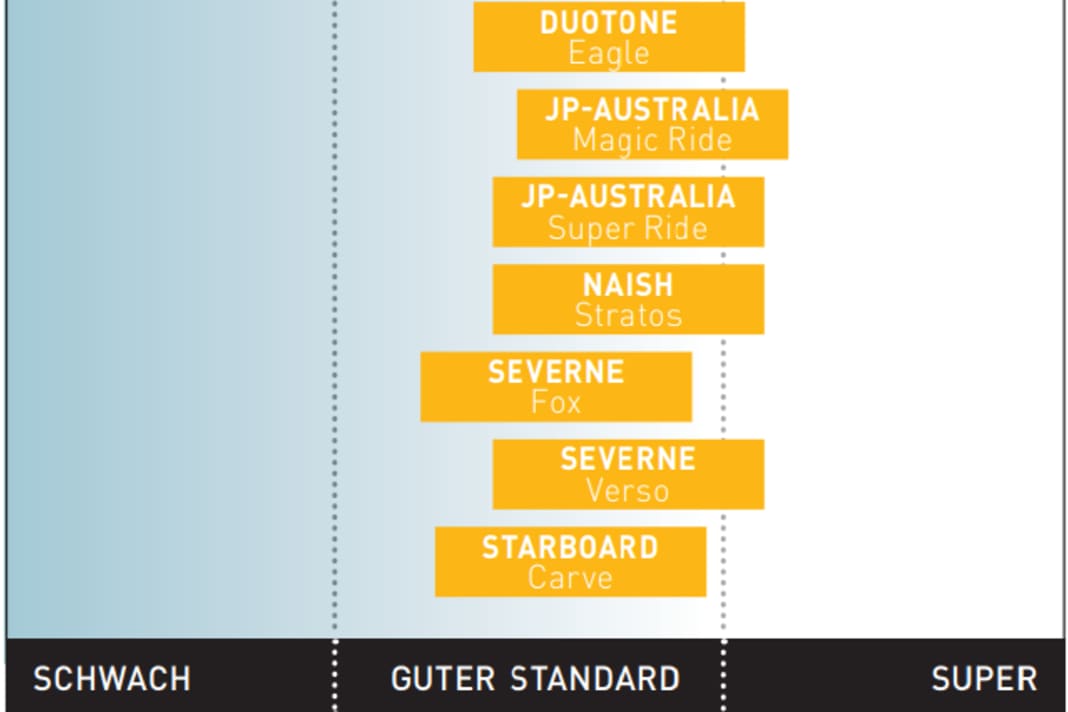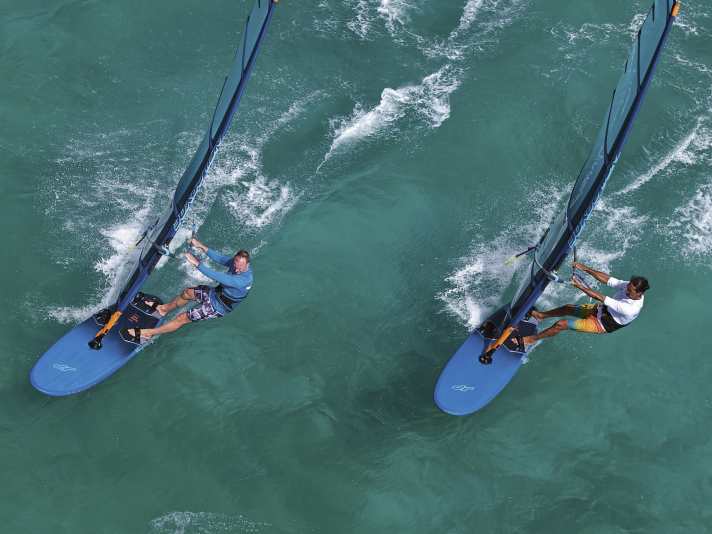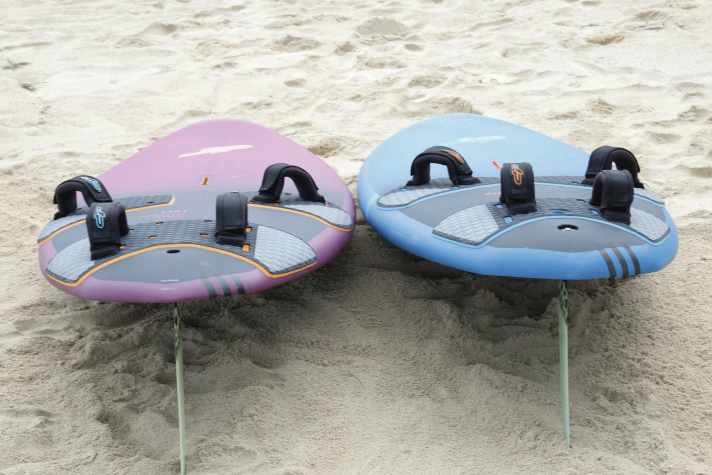





These freeride boards are included in the test:
Are you looking for the perfect freeride board that will inspire both beginners and experienced windsurfers on the water? Then you've come to the right place! We have taken a close look at a diverse selection of freeride boards with a volume of around 125 to 130 litres to find out which board offers you the best windsurfing experience. Whether you're just conquering the foot straps or you're already making fast jibes and riding at high speed - these boards are designed for easy windsurfing, good comfort and the best possible performance.
However, the mix of these characteristics varies depending on the model, and some boards lack one ingredient completely. The small wave-graphics in the reviees show you at a glance how suitable a board is for planing beginners, freeriders or speed-orientated freeracers in the individual assessments of the test boards. The most important rating for you should be no less than seven out of ten points. The text descriptions then tell you in detail how precisely a shape has been tailored to your individual needs. And the scores ultimately reflect what four testers surfed out over hundreds of kilometres on the water.
The marks of the freerideboards 2025






More important than the subtle nuances between two boards is where the most important criteria for you is found in the "weak", "good standard", "super" range. All characteristics that seem particularly important to you should not cover the "weak" category by even a millimetre. Because "weak" means what it says: that even tight jibes, for example, are still somehow possible with a board, but don't necessarily set your surfing senses alight. At the other end of the spectrum, for example, all boards are at least suitable for power jibes. If it's already heading towards "super", then that's exactly what we mean. There is always a "super" when you can only lure the testers away from a test board with treats.
Freerideboards 130: Shapes and features
Of course, you will also find all the information you need to make a purchase decision in the individual descriptions.
You can also find all shape and feature details for all boards at a glance here - and in our video:
Strap positions
The good news is that all boards have a classic freeride position - a set-up with four straps that offers a good compromise between easy entry and good performance. An additional, further inboard option makes it much easier for advancing learners (except on the Severne Fox). A set-up with a single strap at the back is not necessary for these board sizes, however, as there is more than enough space to the edge on the wide tails even with double straps.
If the straps are simultaneously moved significantly forwards when switching to the inside position, planing is even easier, but the maximum performance is also reduced somewhat: The board is pushed flatter into the water, which prevents the best possible top speed as it can no longer fly completely free. If you want to make your first attempts at jumping over small ramps with the freeride board, you should also mount the straps in a rear position.
On the Naish Stratos, the straps and fin are positioned unusually far back - with a noticeable bouncy effect. If you prefer to press your heel against the side of the rail for maximum performance, you won't find the perfect plugs on the Naish. The front rows of straps in particular are positioned quite far inwards on a rather flat deck. Surprisingly, despite the very sporty overall characteristics of the Starboard Carve, getting into the straps is quite easy, as there is still enough distance to the rail even on the narrow tail. In addition, the board planes very stable around the longitudinal axis and does not - like its freerace rival Severne Fox - bend directly to the left or right when changing your weight on the way into the straps.
Planing and performance
Bitchy when planing; once up to speed, unstoppable - this is how the two most extreme shapes in the group can be described in a nutshell. Whilst the classic freeriders planing on a half-wind course are predominantly very harmonious, linear and without much resistance (particularly easy: Naish Stratos and Magic Ride; somewhat more restrained: the Bruch Freedom), the Severne Fox and Starboard Carve require more technique, especially when the wind is just sufficient for planing.
On freeride boards, you can quickly and safely place your front foot in the strap and pull your back foot in while the board continues to plane stably. Once you have overcome the first hurdle on the Fox - threading in the front footstrap - the more challenging part begins. Especially in the outside position, there is little space between the foot strap and the rail, and the board tends to snake if you need more time for the back foot than for a Formula 1 pit stop. Intermediates therefore have much more fun with boards like the Verso from Severne and experience almost the same performance. Only with very good freeride or freerace skills can you get the last five per cent more out of a Fox or Carve.
While the speed ranking was fiercely contested in the test from third place onwards, these two boards clearly set themselves apart. However, this also only applies with straps on the outside, with fast sails and a very good feeling for the fin pressure in the back foot. The advantages of the more moderate freeride shapes - in choppy water, in strong winds and especially in manoeuvres - can be experienced with any level of riding ability.
Learn and improve your power jibe
You don't need a board with insane variability to learn the power jibe, it's enough if one radius sits securely. The Severne Fox can be carved very sportily through the jibe with a high level of riding ability - with centrifugal forces that feel like 3 g pressing you into the straps. In relaxed power jibes, however, the board reacts sensitively to chop and, above all, the strap positions are not suitable for intermediates.
The Naish Stratos and Magic Ride stand out once again from the field of boards that are otherwise all suitable for learning to jibe, because they hold their line in the jibe as securely as if an assistance system were on board. But the Eagle and Verso are also an ideal choice if you want to learn to jibe with the best possible support. If you can already jibe constantly, then the models with variable radii that also carry a lot of speed through the turn come into play. The Bruch Freedom, Duotone Eagle, JP Magic Ride, JP Super Ride and the Severne Verso are almost equally impressive.
The carving jibe - pushing the board through the jibe with the sail laid low and rather flat and far over the edge - is the glory of the windsurfing career for some (free) racers, but is too tedious for most freeriders and offers no advantages. The JP Super Ride, Severne Fox, Severne Verso and also the Duotone Eagle are the best at mastering this demanding, sporty ride on the rail.
Width vs. volume
The JP-Australia Super Ride does not fit exactly into the group in either the 125 litre or 135 litre size with widths of 73 and 77 centimetres. Reason enough for a comparison: the 135 litre seems significantly larger, planes longer through wind holes and is much better on closehauled courses. The differences in top speed and control were surprisingly small.

Freeride Sport vs. Freeride Comfort
In contrast to car-tuning, "lowering" freeride boards provides more comfort: on the thin Magic Ride (left) you are close to the water, the Super Ride has chunkier edges for more performance. The wide board (left) makes the power jibe easier, the narrower board looks sportier in the turn.

Type and size recommendation
Careful selection is more important than ever in this group, because boards as extremely different as the Naish Stratos or Starboard Carve are all labelled with the same freeride title.
- Advancing leaners need a stable board that planes quickly and easily, even on a half-wind course and without the need for much experience, that does not complicate the entry into the straps with unnecessary hurdles and that is stable and easy to plane and power jibe. The top boards are Duotone Eagle, JP Magic Ride, Naish Stratos and Severne Verso. Riders up to around 70 kilos are usually well advised with the tested sizes. If you weigh more, it is generally better to go for at least the next larger model, as the biggest mistake in an aspiring surfer's career is a board that is too small. Boards with a volume of more than 150 litres not only make all the basics easier, but can also provide good windsurfers with a lot or even more fun in a solid planing wind.
- Freeriders who want to go fast with camberless freeride sails, but also value manoeuvres and don't constantly have their eyes on the GPS watch, will find the largest selection with subtle differences in characteristics. In addition to the somewhat more specialised, but well-suited Bruch Freedom are the classic freeriders Duotone Eagle, JP Magic Ride and Super Ride, Naish Stratos and Severne Verso. The Starboard Carve is also just in this group, with minor compromises due to the higher demands on riding ability.
- Freeracers who like to blast across the lake with freerace sails (with or without camber) will find the perfect boards with Severne Fox and Starboard Carve, easy-to-control hotshots that can be really fun for advanced riders. The border crossers between freeride and freerace, Severne Verso and JP Super Ride. They are not quite as snappy, but still sporty and simple at the same time.

